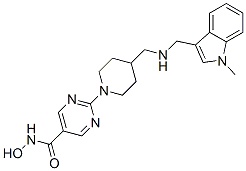All AbMole products are for research use only, cannot be used for human consumption.

JNJ-26481585 (Quisinostat) is an oral histone deacetylase (HDAC) inhibitor with IC50 values of 0.11 nM, 0.33 nM, 0.64 nM, 0.46 nM and 0.37 nM for HDAC1, HDAC2, HDAC4, HDAC10 and HDAC11, respectively. JNJ-26481585 fully inhibited the growth of C170HM2 colorectal liver metastases, whereas again 5-fluorouracil/Leucovorin showed modest activity. JNJ-26481585 exhibits broad spectrum antiproliferative activity in solid and hematologic cancer cell lines, such as all lung, breast, colon, prostate, brain, and ovarian tumor cell lines, with IC50 ranging from 3.1-246 nM, which is more potent than vorinostat, R306465, panobinostat, CRA-24781, or mocetinostat in various human cancer cell lines tested. Once daily oral administration of JNJ-26481585 induced continuous histone H3 acetylation. JNJ-26481585 is currently in a phase II clinical trial for the treatment of previously treated cutaneous T-cell lymphoma.
| Cell Experiment | |
|---|---|
| Cell lines | colo-205, HT-29, HCT-116, H460, H1229, DU145, and A2780 cell lines |
| Preparation method | Cell proliferation and apoptosis assays. All cell lines were obtained from American Type Culture Collection and cultured according to instructions. The effect of HDAC inhibitors on cell proliferation was measured using an MTT as described (12). Proliferation of non–small cell lung carcinoma (NSCLC) cell lines was assessed using an Alamar Blue–based assay as described (12). For proliferation of hematologic cell lines, cells were incubated for 72 h and the cytotoxic activity was evaluated by MTS assay. Data are presented as mean IC50 or IC40 ± SD of at least three independent experiments. For apoptosis assays, human tumor cells were incubated for 24, 48, and 96 h with JNJ-26481585 at the indicated concentrations. Cells were stained for Annexin V and 7-AAD, according to the manufacturer's instructions and analyzed (Guava PCA-96 Nexin kit, Guava Technologies). The number of apoptotic and necrotic cells was expressed as a percentage of the total number of cells present in the well. Total cell number was expressed as a percentage of control, and the percentage of apoptotic/necrotic cells present in the absence of compound was subtracted from all values. All results shown are an average of three independent experiments (± SD). |
| Concentrations | 3, 10, 30, 100 and 300 nM |
| Incubation time | 4 days |
| Animal Experiment | |
|---|---|
| Animal models | NMRI nude mice bearing colorectal cancer HCT-116 xenografts |
| Formulation | 20% hydroxypropyl-β-cyclodextrin (final pH 8.7) |
| Dosages | 10 mg/kg once daily for 14 days |
| Administration | i.p. |
| Molecular Weight | 394.47 |
| Formula | C21H26N6O2 |
| CAS Number | 875320-29-9 |
| Solubility (25°C) | DMSO 49 mg/mL |
| Storage |
Powder -20°C 3 years ; 4°C 2 years In solvent -80°C 6 months ; -20°C 1 month |
| Related HDAC Products |
|---|
| CM-444
CM-444 is an inhibitor for HDAC and DNA methyltransferases (DNMT) with IC50 values of 6 nM-0.6 μM and 1.8-2.3 μM, respectively. CM-444 is an inducer for the differentiation of acute myeloid leukemia cells. CM-444 exhibits anti-leukemic activity and improves the survival rate in mouse models. |
| CM-1758
CM-1758 is a histone deacetylase (HDAC) inhibitor. CM-1758 inhibits tumor growth in vivo. CM-1758 induces acetylation of non-histone proteins in acute myeloid leukemia cells. |
| T-518
T-518 is an orally active, selective, and blood-brain barrier permeable HDAC6 inhibitor with an IC50 value of 36 nM for human HDAC6. |
| SE-7552
SE-7552, a 2-(difluoromethyl)-1,3,4-oxadiazole (DFMO) derivative, is an orally active, highly selective, non-hydroxamate HDAC6 inhibitor with an IC50 of 33 nM. |
| BRD9757
BRD9757 is a potent, capless and selective HDAC6 inhibitor with an IC50 of 30 nM. |
All AbMole products are for research use only, cannot be used for human consumption or veterinary use. We do not provide products or services to individuals. Please comply with the intended use and do not use AbMole products for any other purpose.


Products are for research use only. Not for human use. We do not sell to patients.
© Copyright 2010-2024 AbMole BioScience. All Rights Reserved.
